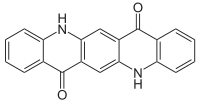Quinacridone
 | |
| Names | |
|---|---|
| IUPAC name
5,12-Dihydro-quino[2,3-b]acridine-7,14-dione | |
| Other names
C.I.: 73900, Pigment Violet 19 | |
| Identifiers | |
| 1047-16-1 | |
| 3D model (Jmol) | Interactive image |
| ChemSpider | 13369 |
| ECHA InfoCard | 100.012.618 |
| PubChem | 13976 |
| UNII | 11P487375P |
| |
| |
| Properties | |
| C20H12N2O2 | |
| Molar mass | 312.33 g·mol−1 |
| Appearance | Red powder (nanoparticles) |
| Density | 1.47 g/cm³ |
| Insoluble | |
| Except where otherwise noted, data are given for materials in their standard state (at 25 °C [77 °F], 100 kPa). | |
| | |
| Infobox references | |
Quinacridone is an organic molecule utilized in the formation of organic pigments. It is an organic compound with the molecular formula C20H12N2O2. Numerous derivatives of quinacridone constitute the Quinacridone pigment family, which finds extensive use in industrial colorant applications such as robust outdoor paints and inkjet toners.[1]
Synthesis
Condensation of succinosuccinate ester with aniline followed by cyclization affords dihydroquinacridone. The latter is oxidized to quinacridone.[1] Derivatives of quinacridone can be readily obtained by employing substituted anilines.
Derivatives
Quinacridones are a family of synthetic pigments used to make high performance paints. Quinacridones are considered "high performance" pigments because they have exceptional color and weather fastness. Major uses for quinacridones include automobile coatings as well as other industrial coatings. They can also be used in artist's paints, including oils, acrylics, and watercolors. Nanocrystalline dispersions of quinacridone pigments functionalized with solubilizing surfactants are the most common magenta printing ink.
Typically deep red to violet in color, the hue of quinacridone is affected not only by the R-groups on the molecule but by the crystal form of the solid. For example, the γ crystal modification of unsubstituted quinacridone provides a strong red shade that has excellent color fastness and resistance to solvation. Another important modification is the β phase which provides a maroon shade that is also more weather resistant and light-fast. Both crystal modifications are more thermodynamically stable than the α crystal phase. The γ crystal modification is characterized by a criss-cross lattice where each quinacridone molecule hydrogen-bonds to four neighbors via single H-bonds. The β phase, meanwhile, consists of linear chains of molecules with double H-bonds between each quinacridone molecule and two neighbors.[2]
Basic modifications to the chemical structure of quinacridones include the addition of CH3 and Cl substituents. Some magenta shades of quinacridone are labeled under the proprietary name "Thio Violet" and "Acra Violet".
Semiconductor properties
Quinacridone derivatives exhibit intense fluorescence in the dispersed state, and high carrier mobility. These properties complement good photo-, thermal, and electrochemical stability. These properties are desired for optoelectronic applications including organic light-emitting diodes (OLEDs), organic solar cells (OSCs), and organic field-effect transistors (OFETs).[3][4] Due to interplay of intermolecular H-bonding and pi-pi stacking, quinacridone can form a self-assembling, supramolecular organic semiconductor. The following image, taken by a scanning tunneling microscope, shows these self-assembled quinacridone chains on a graphite background.
References
- 1 2 K. Hunger. W. Herbst "Pigments, Organic" in Ullmann's Encyclopedia of Industrial Chemistry, Wiley-VCH, Weinheim, 2012. doi:10.1002/14356007.a20_371
- ↑ E.F. Paulus; F.J.J. Leusen & M.U. Schmidt (2007). "Crystal structures of quinacridones". Cryst Eng Comm. 9 (2): 131. doi:10.1039/b613059c.
- ↑ Chenguang, Wang; Zuolun, Zhang; Yue, Wang (2016). "Quinacridone-based π-conjugated electronic materials". J. Mater. Chem. C. 4 (42): 9918–36. doi:10.1039/C6TC03621J.
- ↑ Głowacki, Eric Daniel; Irimia-Vladu, Mihai; Kaltenbrunner, Martin; Gsiorowski, Jacek; White, Matthew S.; Monkowius, Uwe; Romanazzi, Giuseppe; Suranna, Gian Paolo; Mastrorilli, Piero; Sekitani, Tsuyoshi; Bauer, Siegfried; Someya, Takao; Torsi, Luisa; Sarıçiftçi, Niyazi Serdar (2013). "Hydrogen-Bonded Semiconducting Pigments for Air-Stable Field-Effect Transistors". Advanced Materials. 25 (11): 1563–9. doi:10.1002/adma.201204039. PMID 23239229.